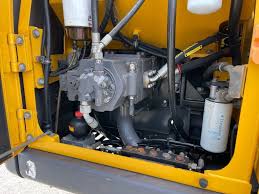This Air Pump Location Diagram for your Volvo EW180 excavator is a schematic diagram that shows the stock location of all hydraulic pumps for a Volvo EW180 excavator. It is not recommended to operate excavators without the installation of aftermarket location verification tools performed by a certified technician.
The Volvo EW180 excavator has an air compressor that acts as a vacuum to expel fumes from the cab
Volvo Construction Equipment, which has already introduced a system to isolate the cab from engine fumes, has developed another solution to the problem in its EW180E excavator. Borrowing technology used in electric cars, the ECR235E excavator is equipped with an air compressor that acts as a vacuum to expel fumes from the cab.
Volvo’s new “Clean Cab” technology was demonstrated recently at a press event organized by Volvo at its North American headquarters in Shippensburg, Pennsylvania.
The Volvo EW180 excavator’s air compressor expels fumes from the cab.
The company said this system allows operators to work in comfort without having to worry about exposure to exhaust gases like carbon monoxide. The operator of a conventional diesel-powered excavator can be exposed to about 1,000 parts per million (PPM) of these gasses — up to 10 times over the recommended exposure limit — depending on ambient wind conditions, according to Volvo.
The air compressor draws fresh air from outside the machine and pushes it through the filters in the engine compartment and into the cab. In this way, it also helps cool engine temperatures so they can run at peak efficiency. The cleaning cycle continues even when the machine is stationary and re-establishes itself automatically.

The air compressor is mounted to the front of the engine compartment and is attached by three bolts
The air compressor is mounted to the front of the engine compartment and is attached by three bolts. The air compressor mounts directly to the engine. As the crankshaft turns it drives a belt on the front of the engine to spin the air compressor pulley. This causes the air compressor to spin too. As it spins, it draws in air from outside and compresses it inside of its metal housing.
After the air is compressed, it moves along a hose through a check valve and in to the holding tank. The check valve is there to keep the compressed air trapped inside of the holding tank so that it can’t escape back out through the hose and past the check valve. This allows more room for more air at higher pressures inside of the tank.
The holding tank allows you to store up plenty of compressed air so that you can use your tools even when your engine isn’t running. In order for this to work, however, you need an air pressure regulator so that you can control how much compressed air enters your tools without damaging them.
The air compressor is mounted to the front of the engine compartment and is attached by three bolts. The belt is routed around the crankshaft pulley, idler pulley, and the air compressor pulley. The tensioner is on the right side of the engine and puts pressure on the belt to keep it tight.
The filter element needs to be replaced after using the machine for 500 hours or once a year, whichever comes first
The filter element needs to be replaced after using the machine for 500 hours or once a year, whichever comes first.
The maximum pressure of the machine is 4.0 bar (58 PSI) and the hose must not be kinked or twisted during operation.
When using the machine, hold it firmly and do not allow it to vibrate excessively. If a rattling sound can be heard, switch the machine off immediately, disconnect it and check for loose parts.
Switch off the machine after use and disconnect it from the mains to prevent risk of accidental starting.
The filter element needs to be replaced after using the machine for 500 hours or once a year, whichever comes first.
1.Disconnect the power supply and water supply to the machine.
2.To remove the top cover, please follow the instruction at “Removing Top Cover” section.
3.Remove the two water inlet hoses on both sides of the machine and then unplug the electrical connectors from both sides of the pump motor.
4.Remove the 4 screws which secure the tank assembly to the base of the unit, then lift up and remove tank assembly from machine base.
5.Unscrew old filter element from housing.
6.Screw new filter element onto housing, with arrow on element pointing in direction toward hose connections (see picture). Make sure to screw filter element down tightly!
7.Install tank assembly back into machine base and secure in place with 4 screws removed earlier; re-install electrical connectors and water hoses to both sides of pump motor; re-install top cover following instructions at “Reinstalling Top Cover” section
The Volvo Ew180 is a mid-sized excavator. It comes with an integrated 8.2 kW (10 HP) air compressor, which is not only great for running the built-in pneumatic tools, but also gives the excavator a longer operating time between air refills than most other excavators of its class. The air pump will last longer between maintenance intervals due to the synthetic lubricants used in the mechanical components.
